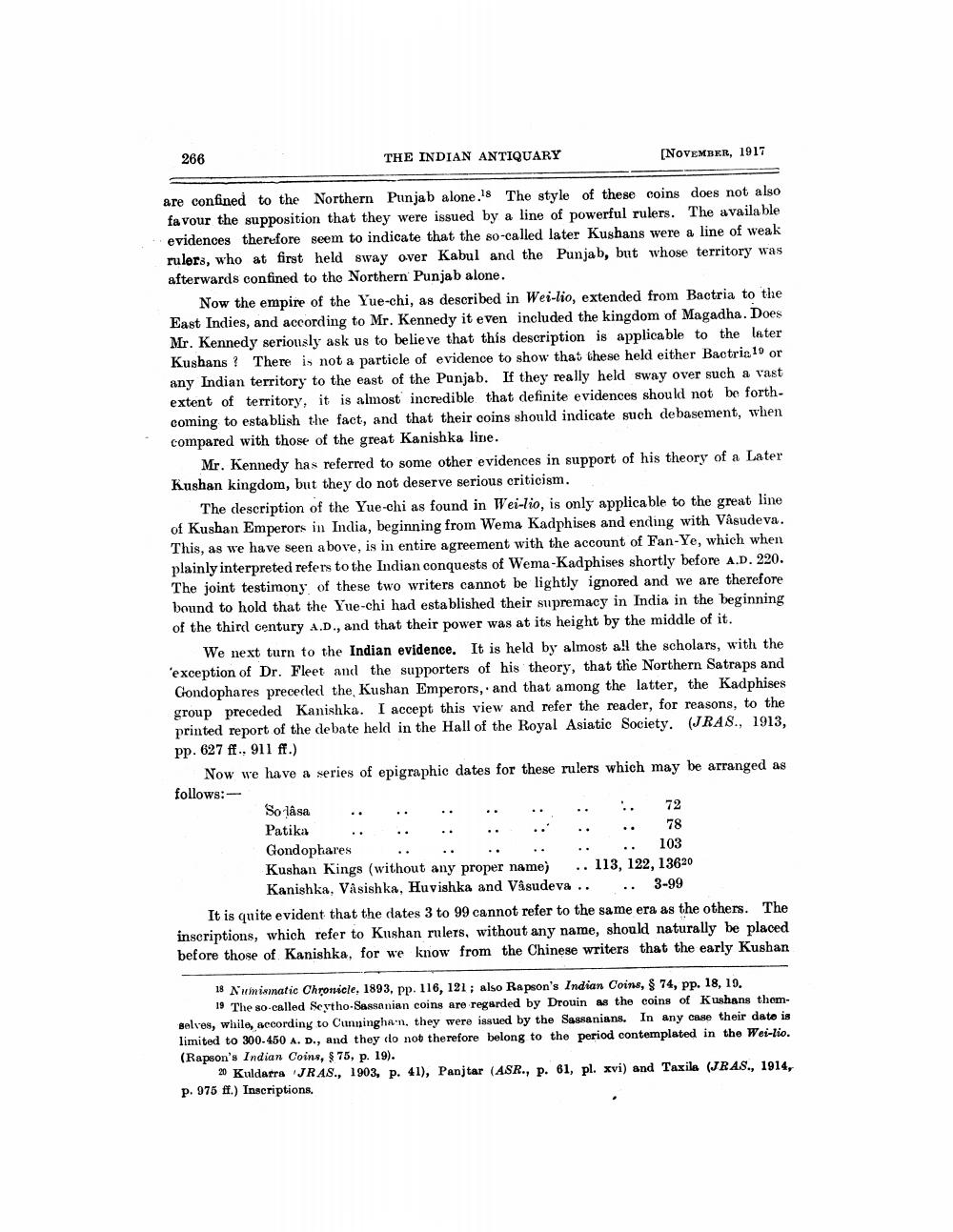________________
266
THE INDIAN ANTIQUARY
[NOVEMBER, 1917
are confined to the Northern Punjab alone.18 The style of these coins does not also favour the supposition that they were issued by a line of powerful rulers. The available evidences therefore seem to indicate that the so-called later Kushans were a line of weak rulers, who at first held sway over Kabul and the Punjab, but whose territory was afterwards confined to the Northern Punjab alone.
Now the empire of the Yue-chi, as described in Wei-lio, extended from Bactria to the East Indies, and according to Mr. Kennedy it even included the kingdom of Magadha. Does Mr. Kennedy seriously ask us to believe that this description is applicable to the later Kushans? There is not a particle of evidence to show that these held either Bactrie 19 or any Indian territory to the east of the Punjab. If they really held sway over such a vast extent of territory, it is almost incredible that definite evidences should not be forthcoming to establish the fact, and that their coins should indicate such de basement, when compared with those of the great Kanishka line.
Mr. Kennedy has referred to some other evidences in support of his theory of a Later Kushan kingdom, but they do not deserve serious criticism.
The description of the Yue-chi as found in Wei-lio, is only applicable to the great line of Kushan Emperors in India, beginning from Wema Kadphises and ending with Vasudeva. This, as we have seen a bove, is in entire agreement with the account of Fan-Ye, which when plainly interpreted refers to the Indian conquests of Wema-Kadphises shortly before A.D. 220. The joint testimony of these two writers cannot be lightly ignored and we are therefore bound to hold that the Yue-chi had established their supremacy in India in the beginning of the third century A.D., and that their power was at its height by the middle of it.
We next turn to the Indian evidence. It is held by almost all the scholars, with the 'exception of Dr. Fleet and the supporters of his theory, that the Northern Satraps and Gondophares prececlecl the Kushan Emperors, and that among the latter, the Kadphises group preceded Kanishka. I accept this view and refer the reader, for reasons, to the printed report of the debate held in the Hall of the Royal Asiatic Society. (JRAS., 1913, pp. 627 ff.. 911 ff.)
Now we have a series of epigraphic dates for these rulers which may be arranged as follows:So lâsa
.. .. .. .. . 72 Patika .. .. .. .. .. .. .. 78 Gondophares
.. .. .. .. .. .. 103 Kushan Kings (without any proper name) .. 113, 122, 13620
Kanishka, Våsishka, Huvishka and Vasudeva .. .. 3-99 It is quite evident that the dates 3 to 99 cannot refer to the same era as the others. The inscriptions, which refer to Kushan rulers, without any name, should naturally be placed before those of Kanishka, for we know from the Chinese writers that the early Kushan
15 Numismatic Chronicle. 1893, pp. 116, 121; also Rapson's Indian Coins, $ 74, pp. 18, 19.
19 The so-called Seytho-Sassanian coins are regarded by Drouin as the coins of Kushans themBelves, while, according to Cunninghan, they were issued by the Sassanians. In any case their date is limited to 300-450 A. D., and they do not therefore belong to the period contemplated in the Wei-lio. (Rapson's Indian Coins, $ 75, p. 19).
20 Kuldarra JRAS., 1903, p. 41), Panjtar (ASR., p. 61, pl. xvi) and Taxila (JRAS., 1914, P. 975 ff.) Inscriptions.




